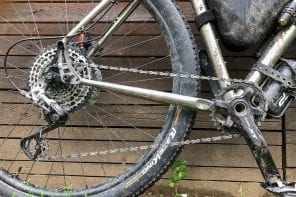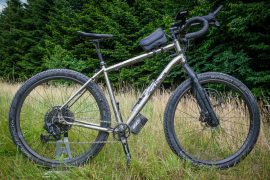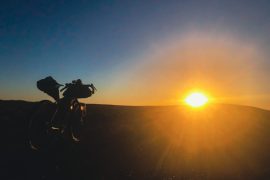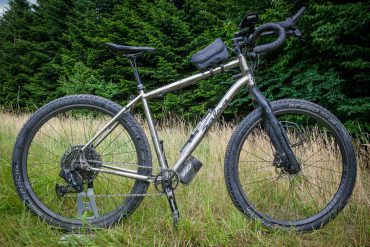A few weeks ago, I wrote about my selection of interesting bikes for bike touring and Bikepacking, including the Ritchey Outback. In this context, I also read Martin’s report in his Lifecycle magazine about his experiences with the bike and was very impressed. So I spontaneously decided to ask for a test of the Ritchey Outback.
Strictly speaking, the Outback is not a complete bike, but a frame-set that can be assembled to your own preferences. Via Daniel from CosmicSports, I got in touch with Ritchey, who kindly provided me with a test bike.

And now I’ve already done a lot of test kilometres and the smile is still on my face. It was the right decision to ask for the Ritchey Outback. This could actually be the end of this test report, because the Outback has taken me by surprise and has landed at the top of my list of possible gravel bikes.
But not so fast, because we still want to take a look into the details and examine them in depth.
But first a short introduction to Ritchey…
Tom Ritchey is one of the most colourful figures in the bicycle scene and is considered one of the inventors of mountain biking. Back in 1974, he also started building individual components and developing frames for other companies. I didn’t know, for example, that Ritchey was the inventor of the 2×9 drivetrain. In addition, Ritchey was significantly involved in the MTB geometries that characterise today’s bikes and also developed the cartridge bottom bracket, among other things. And also the clipless pedal goes back to a Ritchey development. Today, Ritchey is a well-known name and the products, such as stems, handlebars, seatposts and wheels, have an excellent reputation.

Tom himself is still very active and says he rides more than 16,000 km a year. This practical experience is of course reflected in the products and solutions.
The Ritchey Outback 2
In addition to individual components, Ritchey also builds a whole range of frames for road, mountain and gravel bikes. At Velo Berlin last year, I saw the Swiss Cross and also the Outback Break Away, which can be easily “folded” for better transport. You can see where Tom Ritchey comes from, even as an enthusiastic touring cyclist.

And then there is the Outback, which in the new version (2) comes in a beautiful bright classic green. Ritchey calls the colour “Guac y Crema”.
At first glance, the Outback is a classic Graveller, but it has a few features that make it more of a gravelly long-distance racer, with which you can go banging on asphalt, let it rip with grip on gravel and in the forest, and even don’t have to stop at the one or other trail.
This is ensured by the tyre clearance of either 700cc x 48mm or 650B x 2.0″ (50mm).

In addition, mudguards and racks can be mounted on the Outback, should the day trip turn into a longer ride. And the carbon fork, with 3 eyelets and a weight allowance of 3kg per side, also offers enough capacity for one or two additional pieces of luggage on a Bikepacking adventure.
Frame & Fork
At the centre of attention is, of course, the rather classic frame made of Ritchey Logic steel. It is surprisingly filigree and, at 2,175g, not particularly heavy. I like this simple look and the clear shapes.

The derailleur hanger is made of steel and replaceable, and 12x142mm thru axles are used. The bottom bracket is 68mm wide and the brakes are flat-mounted. This means that the frame is well prepared for classic road and gravel gears.
The fork is made of carbon and is called the Ritchey Adventure Fork. It is quite filigree and has 3 eyelets on each side. This allows the Outback to carry water or anything cages/fork packs with an additional load of 3kg per side.

A 12x100mm thru axle is provided here for wheel attachment. The weight is 445g.
With its long chainstays (453mm), the Ritchey is designed more for comfortable rolling and, with a flat steering angle, less for agility. But my off-road experience was different: it is quite agile, but runs more smoothly than the Cannondale Topstone, for example, and also flexes more. The steering is quite direct, but it matches the overall smoothness of the bike.

It has good propulsion, but doesn’t tend to dance when it gets rough, over roots or stones. The geometry and seating position make the Outback a good long-distance runner. Many hours in the saddle are no problem at all, also because the handlebars allow many grip positions and thus reduce the strain.
I had frame size L for the test. The reach is 390mm, the stack 587.4mm and the head tube angle 71 degrees. In addition, the top tube length is almost 570mm and the “wheelbase” (distance between hubs f/r) is almost 1070mm. This makes the bike comfortable to ride and not too “racing” like crossers. Nevertheless, it is very agile off-road and can be pushed hard.
With a total of 3 pairs of eyelets on the frame, the Outback also has enough for water transport in the frame triangle and an additional mount on the down tube. If I had one wish, it would be for eyelets on the top tube to attach a cockpit bag.

But we need to talk about the cable routing on the top tube again: Why does the shift cable have to go openly along the side at the top and not at least along the bottom of the top tube?

I didn’t understand that, especially as it makes the use of a frame bag more difficult.

I rode with a frame bag anyway and it worked without any problems. However, this solution is not so elegant in my opinion.

The total weight of the Ritchey Outback frame/fork set is 2,620g. That is ok. The test bike weighed 10.3kg including pedals. Again, I found that light.
The price for the frame-set is 1,500 euros, which is rather high.
Excursus: Outback frame geometry in comparison
As I immediately felt comfortable on the Outback, I was interested in how its geometry differs from that of other gravel bikes.
To do this, I first went to the well-known Bikegeo.net and compared the Outback with the Rose Backroad and the Cannondale Topstone. This clearly shows the longer chainstay of the Outback and the more stretched geometry compared to the other bikes.
Unfortunately, I couldn’t determine the exact fork length of the Topstone, which is why I investigated further and then stumbled across the fantastically nerdy (and thus for me only partially understandable) site Bikeinsights.
Here you can compare the geometry of almost any bike model and get an incredible amount of data as well as a summary for simple people like me.
I therefore compared the Outback with the Cannondale Topstone, the Cube Nuroad, the Rose Backroad and the Canyon Grail to get a feel for the differences in geometry.

Explanation: The bluer the average reach/stack, the more upright you sit. The more it goes in the red direction, the more “aggressive” aka racier you sit. In essence: blue = gravel-travel, red = race.
Interestingly, the Topstone and Nuroad are less aggressive than the Outback. I would have judged that differently from my memories of testing the Topstone. The Rose Backroad is known as a bike on which you sit more upright. Only the Canyon Grail Gravelbike I chose here is more of a crosser and therefore differs significantly in its geo.
I also took another look at the difference to my Salsa Fargo, which is already very obvious.
Wheels & Tyres
The Ritchey Outback in the test version primarily had Ritchey original components. The wheels were also from Ritchey. Specifically, the WCS Zeta wheel-set was used. The 700cc tubeless rims are made of aluminium and have a width of 24.4mm (outside).

There are 20 spokes at the front and 24 at the rear. This saves weight, of course, but is still stable enough to ride off-road. The wheel-set weighs only 1,468g (648g front/ 820g rear). However, this is also due to the Ritchey “superlight Phantom Flange hubs”. Only a long-term test can show what they can do and how they will last.

And of course I can’t estimate to what extent these wheels will withstand my 8,000 watts in the long run.
The wheelset costs about 600 euros, which is okay.
Ritchey is also being used for the tyres. On the test bike, Speedmax 700x40mm were used. They give enough grip on gravel and even when it was wet and muddy – as it usually was during my test rides – they gave good traction. Every now and then it was more drifting and let’s see, but that was partly due to my speed and partly due to the different air pressures I tried. Overall, I can give the Speedmax a positive rating. They are definitely fast and are certainly a tyre for an Orbit360 on speed…

But: I don’t have much experience with gravel tyres, as I haven’t ridden a gravel bike “privately” so far. Therefore, read this tyre assessment with caution.
If you like it wider, you can also ride the Outback with 650B wheels. Officially up to a tyre width of 2 inches, unofficially 2.1 inches are also possible.
Gear system & brakes
I had hoped for it and was even more pleased to be able to ride the Shimano GRX on the Outback. On the test bike, a 1x GRX was installed with a GRX 11-42 cassette.

With a SRAM Rival, you shift using the shifter on the brake lever alone, whereas with the GRX you move the brake lever to downshift and the shifter to upshift. You get used to this within seconds. I was impressed by the shifting performance, even under load. The GRX rear derailleur works quietly and precisely. In short, it’s just as much fun as the bike itself.

A 40 mm crank spins at the front, which comes from Praxis along with the bottom bracket. In combination with the GRX, this makes for quite a high-quality drivetrain. With 40 on 11-42, you get a gravel-suitable gear. With light baggage, you can definitely master mountains off-road.

Real Bikepacking with a bit more luggage or in challenging terrain will quickly bring a 40/11-42 to its limits in my opinion. But that’s not a bad thing, because the Ritchey allows cranks from a minimum of 36 to a maximum of 46 with 1-speed. With 2-speed, 46/30t to 50/34t are possible. So you can build a small mountain goat out of it – or a road train.

The brakes are also GRX. Here the hydraulic disc brakes with Ice-Tech discs are used. Ritchey specifies 140 to max. 160mm discs on the Outback. However, this should be more than sufficient for most uses with light luggage.

As expected, the brakes work well and precisely. I like it very much. The difference to my semi-hydraulic TRP HY RD is not that big.
Handlebar, saddle & stem
The handlebars, saddle and stem are also from Ritchey. I found the WCS Venture Max handlebar very comfortable. On the one hand, I like the flat top of the grip, which offers a little more comfort for the hands. Ritchey calls it Aero-Shaped. And for another, I’ve never ridden in the lower handlebars as much as I do with the Venture Max.

Its 24 degrees of drop flare are very comfortable. This gives me really a lot of control over the bike at the top as well as the bottom and I can reach the gears/brake easily at all times. In addition, the wavy/knobbly end of the handlebar is very pleasant on straight stretches when you just want to ball and relieve your hands. The WCS VentureMax could therefore be an alternative to my Beyond handlebar.

In addition to the test bike, I also got the new WCS Venture Max XL in 52cm width. Tobias is testing it on the Salsa and there will be an extra report on that.

The saddle and seat post are the WCS Skyline with WCS 27.2mm seat post. I can’t say much about the saddle after the test kilometres, except that I sat on it and didn’t experience any problems. For a saddle, inconspicuous is probably a positive sign.

The stem is also from Ritchey. A WCS C220 is installed here.
Conclusion on the Ritchey Outback

I think testing a bike has a lot in common with tasting whisky. There are the hard and smoky varieties that first burn out the roof of your mouth and drain you of all vital energy. But the more you try them, the better they get, the more you get used to them and the more you acquire a taste for them.
Then there are the varieties that are rather inconspicuous at the beginning, glide gently and pleasantly on the tongue and only later unfold their full flavour and excite. And then there are the whiskies that are simply full-bodied right from the start, develop the aromas at the right time and then don’t let up, but taste even better and better the longer the sip lasts or lags behind. It fits right from the start – without compromise. And the Ritchey Outback is just such a whisky for me.
I sat on it and rode it for 10m and knew: we fit together.
Of course, I carefully select the bikes for my tests. So the probability of being disappointed here is quite low. But the fact that it clicks right from the start is quite rare.

The Outback is a classic steel bike, rather simple in appearance and design. You have to like that, of course. What I like is that it doesn’t try to be a road bike or a crosser with wide tyres, but just a gravel bike. With the Salsa, I tend to ride more upright and optimised for long distances, and I was surprised that the sportier and more stretched geometry of the Ritchey appeals to me. I can ride it for a long time without any problems.
When a mountain biker builds a gravel bike, the Outback is the result.
From my point of view, the bike is interesting for all those who come from a touring/trekking and mountain biking background and are looking for a gravel bike with which, on the one hand, they don’t have to make many compromises in the terrain and, on the other hand, don’t have to cross like a cat a la Van der Poel through the terrain. It rides well from the start, but with forward propulsion. And off-road, it almost seems as if it switches gears and safely mills through fields and forests.

To be honest, I’ve never jumped with a bike as often as with the Outback. It’s fun to ride, also because it’s quite light at about 10 kg (in the test configuration). And if it breaks away in the terrain, you can control it again very quickly, also because the steering is direct but not so jagged.
The Ritchey Outback is a bike for adventure, but it can also deliver results.
I rode it with 700cc tyres. With it, I’m quite confident that I can ride fast on an Orbit360. With 650B tyres, the gravel racer becomes a more trail-ready wide-tyre road bike with which you can venture more into the terrain. If I were to buy the Outback, it would probably be with two sets of wheels.
And best of all: as a passionate touring cyclist, the Outback gives me the option of switching from Bikepacking back to classic touring cycling at any time and equipping the bike as a randonneur with a rear rack, mudguards and fork bags.

What is missing, fortunately, is an explanation for the cable routing on the top tube and a hub dynamo for good light even off-road. But the Outback is essentially what you make of it and how you want to build it. Single or double – it’s all no problem.
The frame-set price of 1,500 euros is quite high, though.
And if you have the opportunity, try the Shimano GRX – together with the Ritchey it’s a great experience. And as you can read in the Radavist review, it’s often the right combination of components that turns a good bike into a perfect one.
Anyway, the Ritchey Outback deservedly has its place in my list of bikes to watch for 2021. What’s more, the bike was recently ennobled by Bikepacking.com, who also named it one of the top bikes in 2020.
And if you’re now interested, you can find more test reports here:
- Martin on an orbit ride with the Ritchey Outback in Lifecycle magazine (in German only)
- Florian from Velomotion about the Ritchey Outback (in German only)
- Bikepacking.com about the Ritchey Outback
- Radavist about the Ritchey Outback
The Ritchey Outback at a glance
Name: Ritchey Outback 2
Frame: Steel Ritchey Logic tubeset, triple butted
Fork: Ritchey Carbon Adventure; max load 3kg per side
Thru axles:
- 12x142mm rear
- 12x100mm front
Brakes: Flat Mount 140-160mm Disc
Tyre clearance & compatibility: 700 x 48mm or 650 x 2.0″
Bottom bracket width: 68mm
Drivetrain: 1-speed or 2-speed
- Min/Max drivetrain size 1-speed: 36 to 46t
- Min/Max bottom bracket size 2-speed: 46/30t to 50/34t
Bottle cages: 3 pairs of eyelets
Weight:
- Frame 2,175g
- Fork 445g
- Test bike with Shimano GRX incl. pedals: 10.3kg
Sizes: XS / S / M / L / XL
Price: 1,449 euros (frame, fork, headset)







Ritchey told road.cc that the thin wall thickness in the middle of the top tube will not support braze-ons. This the cable held in tension with cable stops. I use a extra length of housing so as not to rub the straps of a top tube bag.
The routing on mine is the only thing I’m not absolutely delighted with on mine. I run segmented housing and extend the inner sleeve housing the entire length of the cable. Maybe I’ll upgrade to AXS someday and it will be a non-issue
How tall are you? It would be helpful to tell us what your height is not just what frame size you are using.
Hi,
I am 1.84m tall. But this is only one criteria.
Hope that helps.
Martin
Merci !
At least what we can call a complete review with a look to the geometry of the frame, an essential point to assess !!!
Sehr Profi, Danke schoen 😉